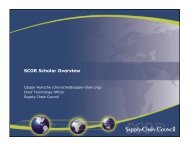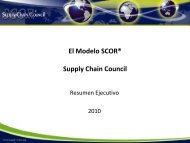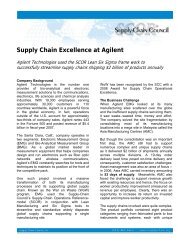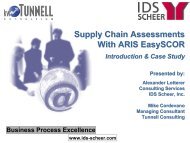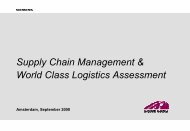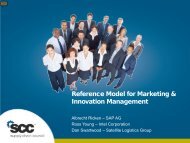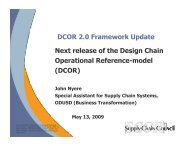ARIS Business Performance Edition - Supply Chain Council
ARIS Business Performance Edition - Supply Chain Council
ARIS Business Performance Edition - Supply Chain Council
You also want an ePaper? Increase the reach of your titles
YUMPU automatically turns print PDFs into web optimized ePapers that Google loves.
<strong>ARIS</strong> Products for Enterprise-Wide<strong>Business</strong> Process ManagementEnterprise <strong>Business</strong> Process ManagementThanks to the new <strong>ARIS</strong> <strong>Business</strong> <strong>Performance</strong> <strong>Edition</strong> products,process owners, departmental managers, and process managerswithin the organization can boost corporate success with optimized,flexible, and innovative business processes that integrate businessand IT. The new products of <strong>ARIS</strong> <strong>Business</strong> <strong>Performance</strong> <strong>Edition</strong> givecustomers process transparency, improve process throughput timesby up to 30 percent, and slash costs by up to 50 percent.<strong>ARIS</strong> <strong>Business</strong> Architect, the process modeling tool for BPM experts,and <strong>ARIS</strong> <strong>Business</strong> Designer, which enables intuitive processdescription in the departments, offer a wealth of new functionality inthe <strong>Business</strong> <strong>Performance</strong> <strong>Edition</strong> to improve and simplify modeling.The enhanced graphical capabilities for modeling and model displaysignificantly improve suitability of the models for user departments.Features of <strong>ARIS</strong> <strong>Business</strong> Architect: Six Sigma support new! Versioning of models and objects new! WYSIWYG report designer new! Enhanced graphical display options new! Generic DMS integration new! Methodological enhancements, such as ProcessSchedule and Matrix Modeler new!<strong>ARIS</strong> <strong>Business</strong> Architect – Versioning and model comparison<strong>ARIS</strong> <strong>Business</strong> Architect – Enhanced graphical capabilitiesThe functionalities provided enable users to design models in a moresimple and attractive way – texts, attributes, and symbols can all beindividually formatted and applied. A special WYSIWYG report tool in<strong>ARIS</strong> <strong>Business</strong> Architect also allows users to create customized,targeted process analysis options and result presentations extremelyquickly.Thanks to the simple <strong>ARIS</strong> methodology and central <strong>ARIS</strong> repository,all process information can be edited and read by a wide range ofuser groups across the organization, turning process knowledge intoa major asset within the enterprise. The new versioning functionalityin <strong>ARIS</strong> <strong>Business</strong> <strong>Performance</strong> <strong>Edition</strong> provides optimal processlifecycle support as part of business process management. Thismakes it easier to track the history of process descriptions and theimprovement process. This forms the basis for an efficient processmanagement system with release cycle management fordocumented business processes.6
<strong>ARIS</strong> – Boosting <strong>Business</strong> Process <strong>Performance</strong><strong>ARIS</strong> <strong>Business</strong> Publisher can be used to communicate the processknowledge in the <strong>ARIS</strong> repository to all employees in the enterpriseworldwide. Its Web portal provides access to process data,guaranteeing 24/7 availability of all current process information –regardless of user group size.The new <strong>ARIS</strong> <strong>Business</strong> <strong>Performance</strong> <strong>Edition</strong> contains extensivefunctionality for publishing process knowledge. Users can customizemodel display to suit their own requirements, making process modelsless daunting. The easy-to-configure Web templates, enhancedsearch functionality (which also covers embedded – or “assigned” –documents), and static publishing are further highlights of <strong>ARIS</strong><strong>Business</strong> Publisher in the new <strong>ARIS</strong> <strong>Business</strong> <strong>Performance</strong> <strong>Edition</strong>.Report execution in the Web browser is another powerful tool forusers, adding Web export capability for the established <strong>ARIS</strong><strong>Business</strong> Architect analysis functions.Features of <strong>ARIS</strong> <strong>Business</strong> Simulator: Simulation of process hierarchies Evaluation of organizational structures Interactive simulation(animation of models, statistics, and charts) Simulation of BPMN models new! Process instance schedules new! Shift calendar new!<strong>ARIS</strong> <strong>Business</strong> Simulator enables users to dynamically analyzeprocesses using an advanced simulation engine. The results can beused to optimize workflows, analyze process costs, and improveresource deployment. Weaknesses and bottlenecks can thus beidentified and the quality and efficiency of business processessignificantly improved.Features of <strong>ARIS</strong> <strong>Business</strong> Publisher: Execution of <strong>ARIS</strong> reports in browser front-end new! User-configured model views by hiding or highlightingelements new! Static and dynamic publishing of process content new! Intuitive customization of Web template new! Full-text searches in embedded (“assigned”)documents new! Generic DMS integration new! Creation and linking of version-based exports new!BPMN notation in <strong>ARIS</strong> <strong>Business</strong> ArchitectAs well as business process descriptions, such as EPCs and valuechains, the new Web-based version of <strong>ARIS</strong> <strong>Business</strong> Simulatorenables simulation and evaluation of other notations, e.g., BPMNmodels. This means that technical workflows can be meticulouslyanalyzed and optimized before being executed in IT systems.Simulation results can be quickly and easily visualized using variouschart display options.<strong>ARIS</strong> <strong>Business</strong> Simulator – Identifying weaknesses and bottlenecks7
<strong>Business</strong> Intelligence + Process <strong>Performance</strong> =<strong>Business</strong> <strong>Performance</strong>Process Intelligence &<strong>Performance</strong> ManagementA company's business processes can be compared to the body’snervous system. Success in the marketplace can only be achieved ifthe efficiency of the running processes is guaranteed. Simply usingtarget process models as a basis for analysis is not enough – what isneeded is the ability to see how the operational processes actuallyperform within the enterprise. Live business processes must beefficiently and effectively designed if they are to have a positiveimpact on the company’s bottom line.The new release of <strong>ARIS</strong> Process <strong>Performance</strong> Manager (<strong>ARIS</strong> PPM)allows companies to visualize the processes that are actuallyexecuted, using live data to compare, analyze, and (via keyperformance indicators) optimize them. Best practices are thusrevealed and can be reused. <strong>ARIS</strong> PPM uses defined key performanceindicators (KPIs) to constantly track the performance of real-worldbusiness processes. Organizations therefore use this software tomonitor the SLAs of core processes, such as order processing,procurement, or maintenance and upgrade. This guarantees properand transparent process performance at all times.Typically, companies deploy several different IT systems to support acore process from end to end. By combining the process-relevantdata from multiple IT systems (e.g., ERP, CRM, workflow/legacysystems, etc.), <strong>ARIS</strong> PPM can reconstruct the execution of eachtransaction from start to finish.This makes it possible to display individual transactions in graphicalformat (e.g., as process chains), as well as calculating KPIs, such asthroughput times, deadline compliance, supply capacity, responsetimes, process costs, change frequency, etc.<strong>ARIS</strong> PPM – Automatic generation of an AS-IS process<strong>ARIS</strong> PPM – Evaluating a live sales processFeatures of <strong>ARIS</strong> Process <strong>Performance</strong> Manager(<strong>ARIS</strong> PPM) Measurement and monitoring of KPIs based on actualprocesses Analysis of process structure and communicationbetween organizational units Benchmarking and comparison on business performance Root cause analysis and identification of optimizationpotential Monitoring of service level agreements8
<strong>ARIS</strong> – Boosting <strong>Business</strong> Process <strong>Performance</strong>Real-time monitoring for proactive processcontrol and reaction to exceptionsUsing established ETL mechanisms, the new <strong>ARIS</strong> Process EventMonitor (<strong>ARIS</strong> PEM) extracts data from a wide range of IT systems inreal time to evaluate the efficiency of live processes. A real-timedashboard acts as a kind of process control center, enabling currentperformance of live processes to be analyzed at any given time. Iferrors or exceptions occur, the relevant person is immediatelyinformed so that corrective action can be taken and the source of theerror eliminated. This ensures a consistently high level of processquality, leading to increased customer satisfaction and enhancedcompany performance.Display process KPIs and the chart, cost, andstructure information relating to businessprocesses live in your browserThe new <strong>ARIS</strong> <strong>Performance</strong> Dashboard uses innovative Flashtechnology to provide users with aggregated process informationfrom end-to-end business processes. Interactive value chains,process traffic lights, trend information, and KPI documentation aredelivered via the browser in timely fashion to all process participants.All elements are clearly combined in a single uniform interface.<strong>ARIS</strong> <strong>Performance</strong> Dashboard serves as a central integration layerthat incorporates all performance-relevant process information from<strong>ARIS</strong> products and external sources and presents it to suit specificgroups.Real-time dashboard with exception handlingFeatures of <strong>ARIS</strong> Process Event Monitor(<strong>ARIS</strong> PEM) Event-driven, real-time monitoring of live businessprocesses Link to source systems of choice and filtering of relevantevents Focus on exception handling: Rule-based alert functionand action initiation Error avoidance and proactive risk management Proactive process control via real-time dashboard<strong>ARIS</strong> <strong>Performance</strong> DashboardFeatures of <strong>ARIS</strong> <strong>Performance</strong> Dashboard Management-oriented visualization of businessperformance Display of KPIs and other indicators in association withbusiness processes Integration with all performance-relevant <strong>ARIS</strong>components and external sources Attractive interface with interactive chart elements(Adobe® Flex 2) Integrated dashboard builder9
Tools and Best Practices for SuccessfulSix Sigma Projects<strong>ARIS</strong> Six SigmaSix Sigma (6σ) is a quality management tool based on a data-drivenbusiness strategy, which requires organizations to align allprocesses such that customers benefit from the best possible quality.Six Sigma projects achieve ground-breaking returns on investment(ROI) because companies adopting this method define requirementsin their business processes based on customer needs and use triedand-truestatistical analysis for process optimization. To deliverconsistently perfect products and services, companies first need toestablish perfect processes. Focusing on eliminating process errorsmakes it possible to achieve greatly improved customer satisfaction,higher revenues, and tighter cost control. <strong>ARIS</strong> Six Sigma gives youthe support you need for sustained success in your Six Sigmainitiatives.<strong>ARIS</strong> Six Sigma from IDS Scheer resolves all these problems. Newmethods help organizations to define the scope of their Six Sigmaprojects (SIPOC), identify problems (fishbone diagrams), andmeasure critical success factors (CTX diagrams). Reportingfunctions enable various project documents to be produced, such asRASCI charts. The bottom line is that companies can thus use theDMAIC cycle (Define, Measure, Analyze, Improve, Control) toimplement and communicate Six Sigma projects according to astandardized approach.Information structured in this way can be transferred to MINITAB®,the market-leading software for statistical analysis in Six Sigmaprojects. <strong>ARIS</strong> <strong>Business</strong> Simulator, <strong>ARIS</strong> Process <strong>Performance</strong>Manager, and <strong>ARIS</strong> <strong>Business</strong> Optimizer provide the ideal support forfurther analysis and monitoring of different types of data.Six Sigma – Fishbone diagramSix Sigma is popular with many businesses today, particularly largecorporations, but the same problems keep recurring:1. Although many methods and tools are available, there is nogenerally accepted procedure for conducting Six Sigmaprojects.2. Despite the numerous statistical analysis options, there is noobvious way of accessing the relevant process data.3. The lack of effective process monitoring means that anyincrease in quality achieved through process improvement isshort-lived.Six Sigma – SIPOC diagramFeatures of <strong>ARIS</strong> Six Sigma: SIPOC diagram display new!(Supplier Input Process Output Customer) Fishbone diagram new! RASCI chart report new! Input/output matrix new! Critical-to-x diagram new! Cooperation with Minitab new!10
<strong>ARIS</strong> – Boosting <strong>Business</strong> Process <strong>Performance</strong>Jump Start Your <strong>Business</strong> Processeswith Best-Practice Reference Models<strong>ARIS</strong> Reference Models<strong>Business</strong> processes can only be improved if their weaknesses havebeen identified. At the same time, organizations need to know how togo about enhancing their processes. It has therefore provenbeneficial for organizations to draw on the accumulated experienceof other enterprises that have overcome the same challenge. <strong>ARIS</strong>reference models embody existing best practice by combiningspecific project methods, work packages, and the anticipatedresults. They also provide process models containing data input andoutput and KPIs for benchmarking and performance measurementpurposes.Customers using <strong>ARIS</strong> reference models can reduce the time spenton process design and improve process quality. Benchmarkingagainst established market standards is also possible. IDS Scheer’s<strong>ARIS</strong> <strong>Business</strong> <strong>Performance</strong> <strong>Edition</strong> offers the following referencemodels:Features of reference models: Proven industry standards from various industriescombined in an <strong>ARIS</strong> database <strong>ARIS</strong> ITIL based on the new ITIL version 3.0 new! <strong>ARIS</strong> Easy SCOR based on SCOR version 8 <strong>ARIS</strong> VRM based on the current version (3.0) of theValue <strong>Chain</strong> Reference Model new! <strong>ARIS</strong> Healthcare: Accumulated knowledge and expertisefrom numerous healthcare projects new!<strong>ARIS</strong> ITIL is thus the ideal platform for designing and implementingthe ITIL standard, helping organizations to synchronize their ITsystems with their business needs – fast and at low cost.<strong>ARIS</strong> VRM (Value <strong>Chain</strong> Reference Model)<strong>ARIS</strong> VRM is based on the reference models defined by the Value<strong>Chain</strong> Group and enables businesses to quickly visualize, analyze,and optimize processes. The reference models cover planning,governing, and execution activities (including the reference library)in order to achieve uniform terminology and coherent processdefinition across the entire value chain.<strong>ARIS</strong> Industry Reference ModelsStarting with <strong>ARIS</strong> Healthcare, IDS Scheer is leveraging the industryexpertise and experience of its consultants to create reference modelsfor its customers in 2008. Graphical presentation in <strong>ARIS</strong> produces aneasy-to-understand display of the relationships and dependenciesbetween individual processes, enabling them to be flexibly adapted tocompany-specific requirements. For example, resources involved,documents, or IT systems can be easily added to models. In addition,<strong>ARIS</strong> offers sophisticated functionality for analyzing processes, makingit possible to pinpoint resource bottlenecks, identify system/mediabreaks, compare alternative process options, etc.<strong>ARIS</strong> EasySCOROrganizations seeking to improve their supply chains in line with the<strong>Supply</strong>-<strong>Chain</strong> <strong>Council</strong> (SCC) reference model use predefinedstructures and parameters to optimize their processes. <strong>ARIS</strong>EasySCOR provides best practice supply chain processes overmultiple levels, making it easy for users to identify and implementimprovements. In February 2008, the SCC announced that <strong>ARIS</strong> wouldbe used as the standard modeling tool for its reference models withimmediate effect.<strong>ARIS</strong> ITILBased on the Information Technology Infrastructure Library (ITIL),<strong>ARIS</strong> ITIL offers a comprehensive reference model for documenting,analyzing, and implementing IT processes.Sample process from the <strong>ARIS</strong> Healthcare reference database11
Attend our free <strong>ARIS</strong> webcasts ...... and become a <strong>Business</strong>Process Expert!60 minutes of valuable information on <strong>ARIS</strong>products and solutionsLive software demosLive questions & answersPresented by IDS Scheer product & solution expertsRegister now: www.aris.com/webcasts
Repository-Based Planning, Management, andAdministration of IT ResourcesEnterprise Architecture ManagementCorporate growth and constant change lead to complex ITenvironments, which in turn create the need to centrally manage ITassets. At the same time, the IT architecture must be able to respondopenly and flexibly to changing business processes and supportcorporate objectives. Knowledge of company processes andbusiness-critical IT systems is therefore vital to understanding andmanaging the impact of IT on the organization. Only then canbusinesses make significant reductions in the cost of developing,maintaining, and upgrading IT systems in the medium and long term,while ensuring the flexibility and agility needed to survive in acompetitive environment.<strong>ARIS</strong> <strong>Business</strong> <strong>Performance</strong> <strong>Edition</strong> provides two specializedsoftware products for this purpose: <strong>ARIS</strong> IT Architect and <strong>ARIS</strong> ITInventory. Thanks to the central <strong>ARIS</strong> repository, IT managers havean overview of both technology and business processes.Time-based modeling for project management supportDisplay of standardized IT development plans using quadrantsAn Enterprise Architecture (EA) documents, manages, and analyzesthese complex structures and provides the link between corporatestrategy, business processes, and IT systems.Features of <strong>ARIS</strong> IT Architect: Enhanced modeling and reporting functionalities new! Simple creation of various views of IT developmentplanning new! Establishment of quadrants for IT standardization acrossthe enterprise new! Time-based modeling for project managementsupport new!14
Process-OrientedCompliance Management<strong>ARIS</strong> Risk & Compliance Manager<strong>Business</strong> processes must remain within defined constraints and allrisks that could damage company performance must be taken intoaccount. This is the only way to ensure target-oriented, responsible,ethical, and legally compliant corporate management, coupled witheffective control.and resolved. Every issue is documented from creation to completion,and can be generated in connection with test cases, deficiencies,risks, processes, etc., or independently. The issue workflowfunctionality provides efficient user support for assignment toowners and processing of issues. The module also makes it easier formanagers and auditors to monitor and track the current status of thecontinuous improvement process with regard to the internal controlsystem.<strong>ARIS</strong> Risk & Compliance Manager offers an intuitive user interfaceand a whole range of analysis optionsHere again, <strong>ARIS</strong> <strong>Business</strong> <strong>Performance</strong> <strong>Edition</strong> provides new,powerful functionalities via the process-oriented <strong>ARIS</strong> Solution forGovernance, Risk & Compliance Management (GRC). The coreproduct of this solution package is <strong>ARIS</strong> Risk & Compliance Manager3.1, which replaces <strong>ARIS</strong> Audit Manager 3.0.This tool helps businesses to demonstrate compliance with legalrequirements and manage their risks. Of particular importance is theexistence and correct functioning of the internal control system. The<strong>ARIS</strong> Risk & Compliance Manager product in <strong>ARIS</strong> <strong>Business</strong><strong>Performance</strong> <strong>Edition</strong> contains new modules for issue managementand operational risk management. As an alternative to the usual riskbasedapproach, a control-based procedure is now also possible.This approach significantly boosts efficiency by providing handlingsupport and reducing the number of controls needed in theenterprise.The new issue management module is fully integrated into all theother modules and offers rich functionality to allow improvement ofthe internal control system. The creation of issues for identifiedproblems and weaknesses enables corrective changes to beimplemented – problem situations can be promptly communicatedWith its new issue management module, <strong>ARIS</strong> Risk & Compliance Managerdelivers complete transparencyOperational Risk Management helps organizations to identify anddocument operational risks (e.g., financial or security risks) as part oftheir internal control system. A risk assessment workflow evaluatesrisks from various perspectives, such as loss amount or occurrenceprobability. Where necessary, relevant action is proposed andimplemented to manage the risk and/or minimize its impact. Tightintegration with the issue management module described above isparticularly useful here. Thanks to role-based presentation ofanalysis results, both management and risk owners receive theinformation that is relevant to them, and can access an overview ofthe current situation and monitor the control system at any time. Asingle tool thus provides support for the entire process, from riskidentification, documentation, and analysis through to riskmonitoring.Until recently, “compliance” was a concept confined to experts only:Now, however, businesses give it the very highest priority. The risingtide of regulations and ever harsher sanctions are imposing new18
<strong>ARIS</strong> – Ensuring <strong>Business</strong> Compliancerestrictions on corporate activity. The penalties for non-compliancewith various laws are rigorous, ranging from severe fines andindividual punishment to imprisonment for executives. Ethicalaspects also play a key role, with large corporations often definingtheir own code of acceptable practice. Increasingly, companies arealso appointing internal compliance officers.The importance of compliance to today’s businesses is underlined inan Ernst & Young report entitled “Strategic <strong>Business</strong> Risk 2008 – theTop Ten Risks for <strong>Business</strong>,” which singles out ‘Regulatory andCompliance Risk’ as the greatest strategic challenge facing manysectors in 2008.Companies are constantly being confronted with new laws and anincreasingly regulated environment. A recent example is the 8th EUDirective, also known as the Audit Directive, which must betranslated into national law by the EU member states by June 28,2008. The directive is often referred to as Euro SOX, after the US SOXlegislation (Sarbanes Oxley Act), although the comparison is onlypartly justified. It contains new rules for auditors and audit qualityassurance, regulations for uniform audit standards in companies, andthe requirement to set up an audit committee.In Asia, the Japanese version of SOX has created another newchallenge. J-SOX is the unofficial name for the Financial InstrumentsExchange Law, which tightens the existing information andpublication requirements. The Act applies to all companies listed onthe Japanese Stock Exchange, which must provide proof of aninternal control system from April 2008. <strong>ARIS</strong> Solution for GRC is alsoavailable in a specially adapted version that offers Japanesecustomers a turnkey solution for all J-SOX requirements.Thanks to its process-oriented approach, <strong>ARIS</strong> Solution for GRCsupports comprehensive, enterprise-wide compliance managementand the creation of an efficient internal control system (ICS). Risksare identified, analyzed, evaluated, and finally monitored. Theanalysis phase pinpoints where risks exist in the process, and whenand how often they occur. Test cases and risk evaluations are thencreated.<strong>ARIS</strong> Risk & Compliance Manager provides notification andreminder mechanisms, as well as functionality to track all entries andchanges (audit trail). This enables consistent workflow managementand detailed analysis of results.<strong>ARIS</strong> Risk & Compliance Manager features a Web-basedCompliance Process Dashboard, with KPIs that provide a quickoverview of the status of all GRC activities. For example, theproportion of still open test cases or deficiencies found in a businessprocess can be displayed.In addition to this configurable overview, a powerful front-end isprovided, in which detailed interactive analysis options are availablefor the various features (dimensions). This enables the easycompilation of analyses using Drag and Drop, for example, to list thenumber of deficiencies by region and status.Process owners and department managers benefit from a detailed,ongoing overview of test activity status, so that internal controlsystem shortcomings can be detected and resolved at an early stage.For companies seeking to leverage improvement potential andeliminate bottlenecks, Compliance Process <strong>Performance</strong> Managerprovides more in-depth analysis functions, such as structuralanalysis and automated search functionality (data mining).Features <strong>ARIS</strong> Risk & Compliance Manager Management testing, self-assessments, and auditing Deficiency and sign-off management Survey management Issue management new! Operational risk management new! Control-based approach as an alternative to risk-basedapproach new!In addition, every single test and deficiency process can be analyzedand displayed as a process chain. Aggregated process displays (e.g.,an EPC of the test flow in the first quarter) with probabilities and KPIsreveal structural weaknesses in process execution and enableoptimization potential to be identified in the compliance processes.The data mining functionality automatically flags up potentialweaknesses.19
IDS Scheer AGHeadquartersAltenkesseler Str. 1766115 SaarbrueckenPhone: +49 681 210-0Fax: +49 681 210-1000E-mail:info@ids-scheer.com© Copyright IDS Scheer AG, Saarbruecken, 2008. All rights reserved. The contents of this document are subject to copyright. Any changes, modifications, additionsor amendments require prior written consent from IDS Scheer AG, Saarbruecken. Reproduction in any form is only permitted on the condition that the copyrightnotice remains on the actual document. Publication or translation in any form requires prior written consent from IDS Scheer AG, Saarbruecken. “<strong>ARIS</strong>”, “IDS” ,“ProcessWorld”, “PPM”, <strong>ARIS</strong> with Platform symbol and Y symbol are trademarks or registered trademarks of IDS Scheer AG in Germany and in many othercountries worldwide. “SAP NetWeaver” is a trademark of SAP AG, Walldorf. All other trademarks are the property of their respective owners.ID-Number: BR-Produktbeilage-0408-Ewww.ids-scheer.com



